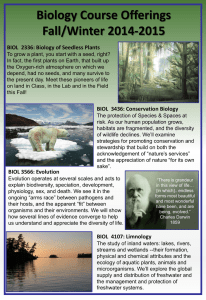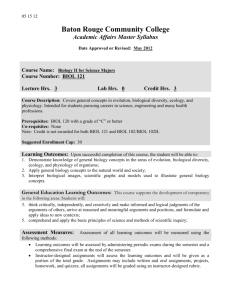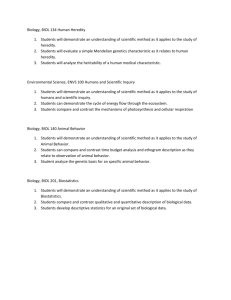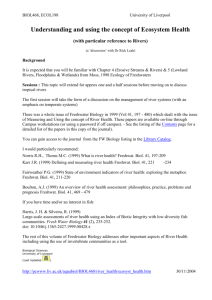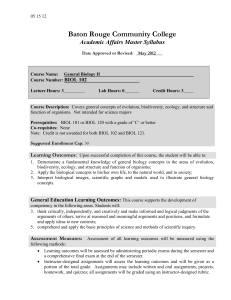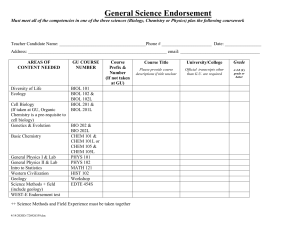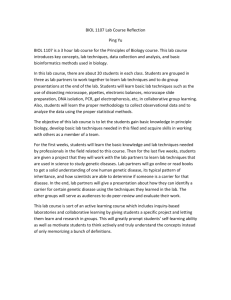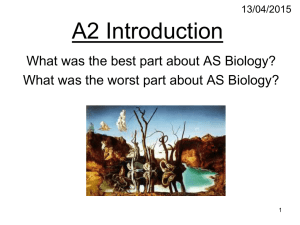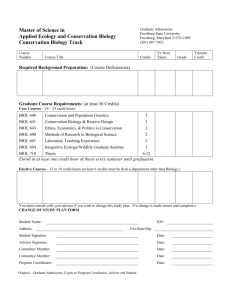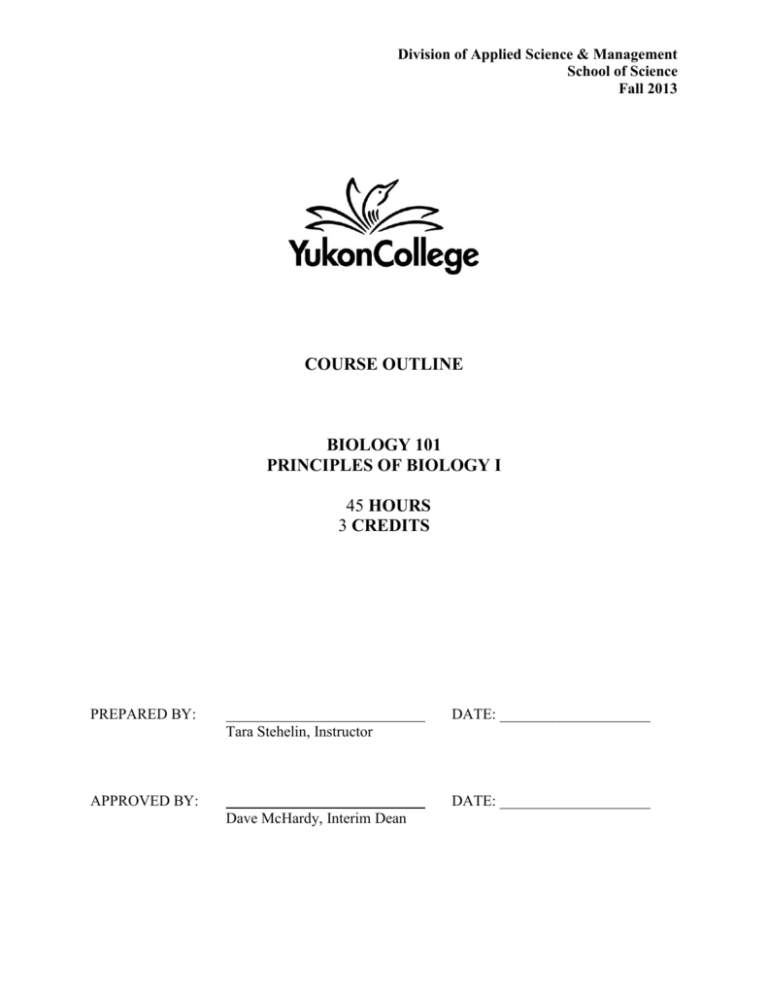
Division of Applied Science & Management
School of Science
Fall 2013
COURSE OUTLINE
BIOLOGY 101
PRINCIPLES OF BIOLOGY I
45 HOURS
3 CREDITS
PREPARED BY:
DATE: ____________________
Tara Stehelin, Instructor
APPROVED BY:
DATE: ____________________
Dave McHardy, Interim Dean
YUKON COLLEGE
Copyright September, 2011
All right reserved. No part of this material covered by this copyright may be reproduced or
utilized in any form or by any means, electronic or mechanical, traded, or rented or resold,
without written permission from Yukon College.
Course Outline prepared by Tara Stehelin, May 25, 2013.
Yukon College
P.O. Box 2799
Whitehorse, YT
Y1A 5K4
DIVISION OF APPLIED SCIENCE AND MANAGEMENT
Biology 101
Credit Course
Fall 2013
BIOLOGY 101, PRINCIPLES OF BIOLOGY I
INSTRUCTOR: Tara Stehelin, B. Sc., M. Sc.
OFFICE HOURS: FRIDAYS 11:00 – 12:30, or by appointment
OFFICE LOCATION: A2806 (behind biology lab)
TELEPHONE: 668-8898
E-MAIL: tstehelin@yukoncollege.yk.ca
FAX: 456-8634
COURSE OFFERING
DAYS & TIMES:
LECTURES Tuesdays and Thursdays 1:00 – 2:30
Room: A2103
LABS: Wednesdays OR Fridays 1:00 – 4:00
Room: A2805 (Biology Lab)
COURSE DESCRIPTION
This course is a core introductory science course, transferrable to most Canadian universities as a
first-year level Biology course, emphasizing principles with wide applications to all living
organisms, including cell structure and function, mechanisms of inheritance, the diversity of life,
evolution and adaptations to the environment. A comparative approach to the unity and diversity
of organisms is stressed. Weekly mandatory lab sessions reinforce subject matter presented in
lectures.
LEARNING OUTCOMES:
Upon successful completion of the course, students will be able to demonstrate knowledge and
understanding of the following:
1. General Biology Learning Outcomes
-the steps taken in rigorous scientific process and what defines a living organism,
including knowledge of the 8 unifying themes of living organisms
2. Ecology Learning Outcomes
-levels of study in ecology and examples of new properties that emerge at each level,
factors that determine and influence distribution of life on Earth based on climate, and
define concepts of habitat, fitness, regulation, niche, concepts of population ecology such
as sample, density, dispersion, mark-and-recapture, and growth models, interpretation of
life tables and survivorship curves, knowledge of life histories
-structure and dynamics of communities, including types of interactions, and how they
influence growth models and diverse adaptations that exist as a result of community
dynamics, trophic structures, concepts of species diversity, keystone species, disturbance
and primary or secondary succession, invasive species
-ecosystem structure and dynamics, including primary production and nutrient cycling
3. Evolution Learning Outcomes
-the observations and main inferences of Charles Darwin such as concepts of evolution,
natural selection, mutation, and sources of evidence for evolution, application of HardyWeinberg equilibrium, causes of evolutionary change (microevolution), patterns of
change in phenotypes resulting from natural selection (macroevolution), causes of
speciation, concept of hybridization and reproductive isolating mechanisms
4. The Diversity of Life Learning Outcomes
-Overview of taxonomic groups and the origin of species, unifying characteristics and
basic knowledge of the diversity within each of the following taxonomic groups;
prokaryotes and the two main kingdoms within, protistans and the five main groups
within, fungi, plants and evolutionary patterns from non-vascular to seedless vascular to
seed plants, evolution and adaptations in angiosperms, evolutionary patterns in animals
from invertebrates, protostomates, segmented animals, to deuterostomates, and finally to
chordates, and the challenges of life on land for both plants and animals
5. Chemical Basis of Life Learning Outcomes
-Unique properties of water that allow it to support life, basic understanding of chemical
bonds, molecules, and atoms, and the elements that make up living things, and classes of
most commonly found compounds found in living things and common functional groups
6. Cell Structure and Functioning Outcomes
-General cell structure, organelles, general structure and functions of each, and the
differences in cell structure among taxonomic groups, functions of proteins in the cell,
communication between cells and jobs of membranes, energy use and basic steps in
metabolism by the cell, control and use of enzymes, mechanisms of transport at the
cellular level
-cellular respiration, redox reactions, and ATP (energy) production
-photosynthesis, light pigments, and production of high energy compounds
Lab Learning Outcomes
Upon completion of mandatory lab sessions students will be able to demonstrate knowledge of
basic ecological practices such as population size and population density estimations, complete
basic statistical exercises, recognize sources of evidence for evolution, identify general groups of
bacteria based on shape, differentiate between prokaryotic and eukaryotic cells, recognize cells
of fungi and protists, and recognize the diversity within Kingdom Protista. Students will be able
to demonstrate correct procedures of microscopy using both compound and stereomicroscopes,
including the ability to use oil immersion and preparation of their own wet mount slides with live
organisms. Students will be able to demonstrate practical knowledge necessary to conduct
dissections on several invertebrate organisms, including clams, roundworms, segmented worms,
crayfish, insects, sea stars, and one (optional) vertebrate, frogs. Students will also be able to
identify organelles within cells and conduct basic laboratory tasks such as incubation of test tube
cultures in a water bath.
COURSE TRANSFER:
Course transfers as first-year biology (first semester) to most Canadian Universities
UBC With BIOL 102, Biol 1st yr: 111/112/140 (6)
SFU BISC 101 (3)
UVIC BIOL 100L (1.5) or with BIOL 102
UAF (University of Alaska Fairbanks) Biol 105x (3) = Biol 190 A&B (3)
UR
With BIOL 102, Biol 100/101 (6)
UAS With BIOL 102, Biol 113 (3)
UNBC Biol 100L (3) Yukon College Biology 101 & 102 = UNBC Biol 100 (4) & Biol (2) 100L
TRU (Thompson Rivers University) Biol 1110
TWU With BIOL 102, Biol 113/114
UBCO (University of British Columbia Okanagan) With BIOL102, Biol 116/125
UFV (University of the Fraser Valley, formerly University College of the Fraser Valley)
With BIOL 102, Biol 111/112
VIU (Vancouver Island University) With BIOL102, Biol 121/122
For more information about transferability contact the School of Science office.
COURSE PREREQUISITES
Admission to the Division of Applied Science & Management. Students who have not
successfully completed Biology 11 are generally not successful in this course. Biology 11 or
equivalent is highly recommended, Biology 12 is recommended. Chemistry 11 is highly
recommended. Math 12 (MATH 060, or other equivalent) is strongly recommended either as a
pre-requisite or co-requisite. Students are expected to possess basic mathematical skills.
DELIVERY METHODS/FORMAT:
Material will be presented in two lectures and one lab session per week. Attendance in the
laboratory is mandatory. Students must pass the lab and lecture portions of the course
independently.
COURSE REQUIREMENTS/EVALUATION:
Attendance and Participation
ATTENDANCE POLICY
Attendance is mandatory in labs and greatly encouraged in lectures. A student may be
withdrawn from a course if a percentage (as stipulated in Yukon College Academic Regulations
and Procedures) of scheduled contact hours are missed in any one course.
Absence from labs results in a zero grade assigned for assignments and quizzes relevant to the
missed lab. If the instructor is notified in advance of potential problems with attendance,
alternate work can be arranged.
Students must attend the laboratory session assigned to them upon registration, once per week.
Assignments
LAB ASSIGNMENTS
Assignments are handed out at the beginning of laboratory sessions and graded on the basis of
understanding and applying principles involved as well as the correctness of answers to
solutions. Most students finish assignments during the lab session, although they are not due
until the next week day. A lab quiz will be given each week during each scheduled lab to assess
progress. Written reports may also be assigned.
Projects
None.
Tests
Quizzes on lecture material are given approximately once every two weeks. There are 5 quizzes
in total, worth 10% each and then a final exam worth 15% of the total mark. The final
examination will be held at the end of the term. It will cover the entire course and the examination
date will be announced as soon as confirmed by administration. Quizzes on laboratory material
are given every lab session (except the first lab) and cover material from the lab exercises the
week before. There is no final lab exam.
Evaluation
On lecture material: five quizzes worth 10% each (50%), and a final exam worth 15% for a total
of 65% of the mark for lecture portion of the course. Laboratory marks make up 35% of total
mark. Laboratory assignments are worth 17.5%, and laboratory quizzes are worth 17.5% of the
total mark. There is no final exam for the laboratory portion of the course.
Plagiarism
Plagiarism involves representing the words of someone else as your own, without citing the
source from which the material is taken. If the words of others are directly quoted or
paraphrased, they must be documented according to standard procedures (APA). The
resubmission of a paper for which you have previously received credit is considered a form of
plagiarism.
Plagiarism is academic dishonesty, a serious academic offence, and will result in you receiving a
mark of zero (F) on the assignment or the course. In certain cases, it can also result in dismissal
from the college. And do not underestimate the impact such a situation will have on your
reputation.
STUDENTS WITH DISABILITIES OR CHRONIC CONDITIONS:
Reasonable accommodations are available for students with a documented disability or
chronic condition. It is the student’s responsibility to seek these accommodations. If a
student has a disability or chronic condition and may need accommodation to fully
participate in this class, he/she should contact the Learning Assistance Centre (LAC) at
(867) 668-8785 or lassist@yukoncollege.yk.ca.
REQUIRED TEXTBOOKS/MATERIALS:
“Campbell: Biology in Focus”, Lisa A. Urry; Michael L. Cain; Steven A. Wasserman; Peter V.
Minorsky; Robert B. Jackson; Jane B. Reece
Publisher: Benjamin Cummings
Copyright year: © 2014 Pages: 1080
Available for purchase in the bookstore
Or
“Campbell Biology” 7th, 8th, or 9th Edition, Reece, Urry, Cain, Wasserman, Minorsky, and Jackson.
Pearson Benjamin Cummings
Lab Manual: assembled by instructor and handed out during first lab session
TOPIC OUTLINE/SYLLABUS
WEEK
TOPIC
1
Introduction to Biology:
- Overview and introduction to biological science
-scientific method
Ecology:
-Diversity of life in the biosphere
2
Approximate Quiz Schedule
3
4, 5,6
9,10
11,12
13
-Population Ecology
-Community Ecology
Evolution and Speciation:
- Evidence of evolution, history, classification,
-Natural selection
-speciation
Diversity:
- The Kingdoms of Life
-taxonomy
-Prokaryotes
-Protists
-Fungi
-Plants
-Invertebrates
-Vertebrates
Cell Theory, Metabolism
- basic chemistry of life
-enzymes
- membrane function
- organelles
- energy flow
Respiration & Photosynthesis
- glycolysis
- aerobic respiration
- glucose production
Quiz 1
Sept 19, 2013
Quiz 2
Oct. 3
Quiz 3
Oct. 17
Quiz 4
Nov. 7
Quiz 5
Nov. 21
Review
Final
Lab Schedule and List of Topics
Lab #
Lab Topic
Lab 1
Ecology 1- The Boreal Forest: Introduction to ecosystems, trophic
structures, plant identification, dichotomous key
(Outside lab)
Lab 2
Ecology 2- Population Ecology and Community Interactions,
population density, quadrat sampling (outside exercise), mark-andrecapture, growth curves, evolution and diversity of community
interactions
Lab 3
Evidence of Evolution / Evolution and Natural Selection, genetic drift,
gene flow, and natural selection exercises
Lab 4
The Microscope Introduction
The Evolution of Biological Diversity – Archaea, Eubacteria, and
Protists
Lab 5
Fungi Diversity, Plant Diversity Part 1 - Seedless Plants
Lab 6
Plant Diversity Part 2 - Seed Plants
Lab 7
Animal Diversity Part 1 - Porifera, Cnidaria, Platyhelminthes, and
Nematoda, Rotifers
Lab 8
Animal Diversity Part 2 - Molluscs and Annelids
Lab 9
Animal Diversity Part 3 - Arthropods, Echinoderms and Chordates
Lab 10
Chemistry of Life – Water
Lab 11
The Cell - Cell structure and function, membrane transport processes
Lab 12
The Cell – Cellular Respiration and Photosynthesis, glycolysis
demonstration using yeast, paper chromatography

